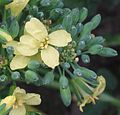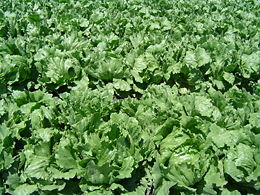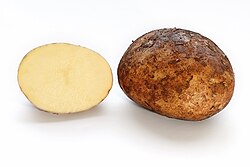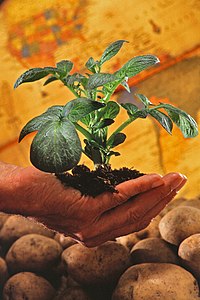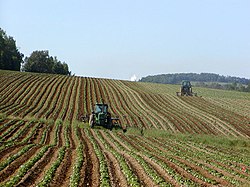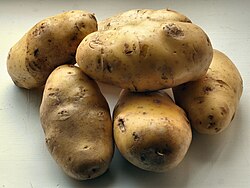Potato (informally tattie, tater, spud, tato, pota, spudzie or tate) is the term which applies either to the starchy, tuberous root vegetable crop from the various subspecies of the perennial plant Solanum tuberosum of the Solanaceae, or nightshade, family, or to the plant itself. In the region of the Andes, the word is also used to refer to other closely-related species of the genus Solanum. Potato is the world's most widely grown tuber crop, and the fourth largest food crop in terms of fresh produce — after rice, wheat, and maize (corn).
Endemic species diversity demonstrates that the potato originated in the area of contemporary Peru and Bolivia,[1] identified more specifically in research published by David Spooner in 2005 as an area of southern Peru, just north of Lake Titicaca.[2] The potato was introduced to Europe in 1536[3], and subsequently by European mariners to territories and ports throughout the world.[4] Thousands of varieties persist in the Andes, where over 100 varieties might be found in a single valley, and a dozen or more might be maintained by a single agricultural household.[5]
Though evidence ranging from historical records, local agriculturalists, and DNA analyses strongly supports the hypothesis that the most widely cultivated variety of potato worldwide, Solanum tuberosum tuberosum, is indigenous to Chiloé Archipelago and has been cultivated by the local indigenous people since before the coming of the Spanish. Today, over 99% of all cultivated potato varieties worldwide are descendants of a subspecies indigenous to South-Central Chile.[6] [7]
Once established in Europe, the potato soon became an important food staple and field crop. Lack of genetic diversity, due to the fact that very few varieties were initially introduced, left the crop vulnerable to disease. In 1845, a fungal disease, Phytophthora infestans, also known as late blight, spread rapidly through the poorer communities of western Ireland, resulting in the Great Irish Famine. The potato is also strongly associated with Idaho, Maine, Washington, North Dakota, Prince Edward Island, Ireland, Jersey and Russia because of its large role in the agricultural economy and history of these regions. But in recent decades, the greatest expansion of potato has been in Asia, where as of 2007 approximately eighty percent of the world potato crop is grown. Since the dissolution of the Soviet Union, China has become the world's largest potato producer,[4] followed by India.[8]
Etymology
The English word potato comes from Spanish patata (the name used in Spain). The Spanish Royal Academy says the Spanish word is a compound of the Taino batata (sweet potato) and the Quechua papa (potato).[9] This probably indicates that originally, the potato was regarded as a type of sweet potato rather than the other way around, despite the fact that there is actually no close relationship between the two plants at all.
In Hindi, the potato is called aloo, but in other North Indian languages, including Gujarati, the potato is called bataka or batata.
Serbian and Slovenian krompir, Romanian cartof, Ukrainian картопля (kartóplja), Bulgarian картоф (kartof), Russian картофель (kartofel), German and Danish kartoffel, Icelandic kartafla, Latvian kartupelis and Estonian kartul all derive from the Italian word tartufoli, which was given to potato because of its similarity to truffles (Italian: tartufo). Although the current Italian term for the potato is patata.
Another common name is "ground apple": pomme de terre in French, aardappel in Dutch, תפוח אדמה in Hebrew (often written just as פוד), and Erdapfel in Austrian German. An analogous name is Finnish as peruna, which comes from the old Swedish term jordpäron "earth pear". In 16th century French, pomme meant "fruit", thus pomme de terre meant "ground fruit" and was probably literally loan translated to other languages when potatoes were introduced. In Polish potato is called just ziemniaki, and in Slovak zemiak, from the word for "ground". In several northern Indian languages and in Nepali the potato is called alu/aloo and in Indonesian kentang.
Different names for the potato developed in China's various regions, the most widely used names in standard Chinese today are "horse-bell yam" (马铃薯 - mǎlíngshǔ), "earth bean" (土豆 - tǔdòu), and "foreign taro" (洋芋 - yángyù).
Description
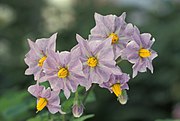
Flowers of a potato plant.
Potato plants grow high to the ground and bear yellow to silver flowers with yellow stamens.
Potatoes are cross-pollinated mostly by bumblebees that carry pollen from other potato plants, but a substantial amount of self-fertilizing occurs as well. Any potato variety can also be propagated vegetatively by planting tubers, pieces of tubers, cut to include at least one or two eyes, or also by cuttings, a practice used in greenhouses for the production of healthy seed tubers.
Some commercial potato varieties do not produce seeds at all (they bear imperfect flowers) and are propagated only from tuber pieces. Confusingly, these tubers or tuber pieces are called "seed potatoes".
After potato plants flower, some varieties will produce small green fruits that resemble green cherry tomatoes, each containing up to 300 true seeds. By finely chopping the fruit and soaking it in water, the seeds will separate from the flesh by sinking to the bottom after about a day (the remnants of the fruit will float). All new potato varieties are grown from seeds, also called "true seed" or "botanical seed" to distinguish it from seed tubers. Potato fruit contains large amounts of the toxic alkaloid solanine, and is therefore unsuitable for consumption.
Origin and history
There is general agreement among contemporary botanists that potato species originated in the Andes, all the way from Colombia and Venezuela to Chile and northern Argentina, but with a concentration of genetic diversity, both in the form of cultivated and wild species, in the area of modern day Peru. The evidence thus far shows that the potato was first cultivated in Peru some 7,000 years ago. The first European description of the potato was in Pedro Cieza de León's Crónica del Perú (Seville 1533). About the same time the potato was introduced into cultivation in Spain, under its Quechua name, papa. A notice of 1573 shows that potatoes were being fed to the sick in a monastery of Seville, still under their Quechua name.
Outside Spain, the potato was a botanical curiosity, judged to be poisonous by the knowledgeable, for its clear relation to Deadly Nightshade. It was introduced in France about 1540 and cultivated at Saint-Alban-d'Ay under the name truffole. It made its first appearance in botanical literature in Gaspard Bauhin's Pinax Theatri Botanici, 1596. Olivier de Serres described the cartoufle in 1600, declaring "This plant called cartoufle carries fruits of the same name, similar to truffles."[10]
The Andean Solanum tuberosum ssp. andigena was the variety first introduced to Europe and dominated European production until a few decades before the Irish Potato Famine, according to recently-published DNA analysis. The same research shows that in the early 19th century, the Chilean Solanum tuberosum ssp. tuberosum, adapted to long-day growing conditions, was introduced to Europe. It quickly replaced the Andean short-day variety.[7]
The potato was grown and eaten in northern Italy, Spain, Germany, Poland, Russia. Popular history credits Sir Walter Raleigh with its introduction to Great Britain and Ireland, although one of his men, Thomas Harriott, is also credited[11]. Only in France was it considered merely animal feed. It introduction to the French kitchen is legitimately credited to Antoine Parmentier, who had been forcibly introduced to it during a period of military captivity in Prussia during the Seven Years' War. Following local shortages in 1769, the Academy of Besançon conducted a competition in 1771 on the theme of vegetables that could supplement those commonly in use during years of want, and what would be their preparation. Parmentier won first prize, among several who were recommending the potato. His stratagem for introducing it among French peasants has become legend; he had a field of potatoes grown near Paris watched (lightly) by royal troops, as if it were a delicacy fit only for nobles' tables. The local peasantry managed to steal samples and the potato was launched in French cuisine, where potato dishes are still styled "à la Parmentier".
Historical and genetic evidence suggests that the potato reached India not very much later than Europe, taken there by either the British or the Portuguese. Genetic studies show that all 32 varieties of potato grown in India derive from the Chilean subspecies.[12] The earliest unequivocal reference to the potato in India is in an 1847 British journal.[13]
Potato genetics
The potatoes cultivated in the Andes are not all the same species. However, the major species grown worldwide is Solanum tuberosum (a tetraploid with 48 chromosomes). Modern varieties of this species are the most widely cultivated worldwide. There are also four diploid species (with 24 chromosomes): Solanum stenotomum, Solanum phureja, Solanum goniocalyx and Solanum ajanhuiri. There are two triploid species (with 36 chromosomes): Solanum chaucha and Solanum juzepczukii. There is one pentaploid cultivated species (with 60 chromosomes): Solanum curtilobum.
There are two major subspecies of Solanum tuberosum: andigena, or Andean; and tuberosum, or Chilean.[14] The Andean potato is adapted to the short-day conditions prevalent in the mountainous equatorial and tropical regions where it originated. The Chilean potato is adapted to the long-day conditions prevalent in the higher latitude region of southern Chile, especially on Chiloe Island where it is thought to have originated.[15]
There are about five thousand potato varieties world wide. Three thousand of them are found in the Andes alone, mainly in Peru, Bolivia, Ecuador, Chile and Colombia. They belong to eight or nine species, depending on the taxonomic school. Apart from the five thousand cultivated varieties, there are about 200 wild species and subspecies, many of which can be cross-bred with cultivated varieties, which has been done repeatedly to transfer resistances to certain pests and diseases from the gene pool of wild species to the gene pool of cultivated potato species.
Potatoes are occasionally referred to as Irish potatoes in the English speaking world because in the earliest years, this signified a distinction from sweet potatoes. Potatoes were widely grown in Ireland after they were introduced, but in 1845, potato blight devastated the crop, precipitating the six-year-long Great Irish Famine.
Most modern potatoes grown in North America arrived through European settlement and not independently from the South American sources. However, at least one wild potato species, Solanum fendleri, is found as far north as Texas and used in breeding for resistance to a nematode species attacking cultivated potatoes. A secondary center of genetic variability of the potato is Mexico, where important wild species are found that have been used extensively in modern breeding, such as the hexaploid Solanum demissum, as a source of resistance to the devastating late blight disease. Another plant native to this region, Solanum bulbocastanum, a close relative of the potato, has been used to genetically engineer the potato to effectively resist potato blight.[16]
The potato became an important staple crop in northern Europe as the climate changed due to the Little Ice Age, when traditional crops in this region did not produce as reliably as before. At times when and where most other crops would fail, potatoes could still typically be relied upon to contribute adequately to food supplies during the colder years. The potato was not popular in France during this time, and it is believed that some of the infamous famines could have been lessened if French farmers had adopted it. Today, the potato forms an important part of the traditional cuisines of most of Europe. Belarus has the highest consumption of potato per capita with each Belorussian consuming 338 kg in 2005.[17][18]
Nutrition

The
toxic fruits produced by mature potato plants
Potato, raw, with peel
Nutritional value per 100 g (3.5 oz) |
| Energy 80 kcal 320 kJ |
| |
Percentages are relative to US
recommendations for adults.
|
Nutritionally, potatoes are best known for their carbohydrate content (approximately 26 grams in a medium potato). Starch is the predominant form of carbohydrate found in potatoes. A small but significant portion of the starch in potatoes is resistant to enzymatic digestion in the stomach and small intestine and, thus, reaches the large intestine essentially intact. This resistant starch is considered to have similar physiological effects and health benefits of fiber (e.g., provide bulk, offer protection against colon cancer, improve glucose tolerance and insulin sensitivity, lower plasma cholesterol and triglyceride concentrations, increase satiety, and possibly even reduce fat storage) (Cummings et al. 1996; Hylla et al 1998; Raban et al. 1994). The amount of resistant starch found in potatoes is highly dependent upon preparation methods. Cooking and then cooling potatoes significantly increases resistant starch. For example, cooked potato starch contains about 7% resistant starch, which increases to about 13% upon cooling (Englyst et al. 1992).
Potatoes contain a number of important vitamins and minerals. A medium potato (150g/5.3 oz) with the skin provides 27 mg vitamin C (45% of the Daily Value (DV)), 620 mg of potassium (18% of DV), 0.2 mg vitamin B6 (10% of DV) and trace amounts of thiamin, riboflavin, folate, niacin, magnesium, phosphorus, iron, and zinc. Moreover, the fiber content of a potato with skin (2 grams) equals that of many whole grain breads, pastas, and cereals. In addition to vitamins, minerals and fiber, potatoes also contain an assortment of phytochemicals, such as carotenoids and polyphenols. The notion that “all of the potato’s nutrients” are found in the skin is an urban legend. While the skin does contain approximately half of the total dietary fiber, the majority (more than 50%) of the nutrients are found within the potato itself. The cooking method used can significantly impact the nutrient availability of the potato.
Potatoes are often broadly classified as high on the glycemic index (GI) and thus are frequently excluded from the diets of individuals trying to follow a “low GI” eating regimen. In fact, the GI of potatoes can vary considerably depending on the type (i.e., red vs. russet vs. white vs. Prince Edward), origin (i.e., where it was grown), preparation methods (i.e., cooking method, whether it is eaten hot or cold, whether it is mashed or cubed or consumed whole, etc), and with what it is consumed (i.e., the addition of various high fat or high protein toppings) (Fernandes et al. 2006).
Potatoes are prepared in many ways: skin-on or peeled, whole or cut up, with seasonings or without. The only requirement involves cooking to break down the starch. Most potato dishes are served hot, but some are first cooked then served cold, notably potato salad and potato chips/crisps.
Common dishes are: mashed potatoes, which are first boiled (usually peeled), and then mashed with milk or yogurt and butter; whole baked potatoes; boiled or steamed potatoes; French-fried potatoes or chips; cut into cubes and roasted; scalloped, diced, or sliced and fried (home fries); grated into small thin strips and fried (hash browns); grated and formed into dumplings, Rösti or potato pancakes. Unlike many foods, potatoes can also be easily cooked in a microwave oven and still retain nearly all of their nutritional value, provided that they are covered in ventilated plastic wrap to prevent moisture from escaping—this method produces a meal very similar to a steamed potato while retaining the appearance of a conventionally baked potato. Potato chunks also commonly appear as a stew ingredient.
Potatoes are boiled between 10 and 25[19] minutes, depending on size and type, to become soft.
Regional dishes
Latin America
Peruvian Cuisine naturally contains the potato as a primary ingredient in many dishes, as around 3,000 varieties of this tuber are grown there.[20] Some of the more famous dishes include Papa a la huancaina, Papa rellena, Ocopa, Carapulcra, Causa and Cau Cau among many others. French-fried potatoes are a typical ingredient in Peruvian stir-fries, including the classic dish Lomo Saltado.
In Ecuador the potato, as well as being a staple with most dishes, is featured in the hearty Locro de Papas, a thick soup of potato, squash, and cheese.
In Chile's Chiloe archipelago, potatoes are the main ingredient of many dishes, including milcaos, chapaleles, curanto and chochoca.
Europe
In Britain potatoes form part of the traditional staple fish and chips. Mashed, potatoes also form a major component of several other traditional British dishes such as shepherd's pie, bubble and squeak, champ and the 'mashit tatties' (Scots language) which accompany haggis. The Tattie scone is another popular Scottish dish containing potatoes. They are also often sautéed to accompany a meal. In the UK, new potatoes are typically cooked with mint and served with a little melted butter - Jersey Royal potatoes are the most prized new potatoes, and have their own Protected Designation of Origin.
In Ireland Colcannon is a traditional Irish dish involving mashed potato combined with shredded cabbage and onion. Boxty pancakes are eaten all over Ireland, although associated especially with the north, and in Irish diaspora communities: they are traditionally made with grated potatoes, soaked to loosen the starch and mixed with flour, buttermilk and baking powder. A variant eaten and sold in Lancashire, especially Liverpool, is made with cooked and mashed potatoes.
In Northern Europe, especially Denmark, Norway, Sweden and Finland, newly harvested, early ripening varieties are considered a special delicacy. Boiled whole and served with dill, these "new potatoes" are traditionally consumed together with Baltic herring.

A baked potato served with butter
In Western Europe, especially in Belgium, sliced potatoes are fried to get frieten, the original French fried potatoes. Stamppot, a traditional Dutch meal, is based on mashed potatoes mixed with vegetables.
Potatoes are very popular in continental Europe as well. In Italy, they serve to make a type of pasta called gnocchi. Similarly, cooked and mashed potatoes or potato flour can be used in the knödel or dumpling eaten with or added to meat dishes all over central and Eastern Europe, but especially in Bavaria and Luxembourg. Potatoes form one of the main ingredients in many soups such as the pseudo-French vichyssoise and Albanian potato and cabbage soup. In western Norway, komle is popular.
A traditional Canary Islands dish is Canarian wrinkly potatoes or Papas arrugadas. Tortilla de patatas (potato omelete) and Patatas bravas (a dish of fried potatoes in a spicy tomato sauce) are near-universal constituent of Spanish tapas.
North America
In the United States, potatoes have become one of the most widely consumed crops, and thus have a variety of preparation methods and condiments. French fries and often hash browns are commonly found in typical American fast-food burger joints and cafeterias. One popular favorite involves a baked potato with cheddar cheese (or sour cream and chives) on top, and in New England "smashed potatoes" (a chunkier variation on mashed potatoes, retaining the peel) have great popularity. Potato flakes are popular as an instant variety of mashed potatoes, which reconstitute into mashed potatoes by adding water, plus butter & salt for taste. A regional dish of Central New York, salt potatoes are bite-sized new potatoes boiled in water saturated with salt then served with melted butter.
A traditional Acadian dish from New Brunswick is known as poutine râpée. The Acadian poutine is a ball of grated and mashed potato, salted, sometimes filled with pork in the center, and boiled. The result is a moist ball about the size of a baseball. It is commonly eaten with salt and pepper or brown sugar. It is believed to have originated from the German Klöße, prepared by early German settlers who lived among the Acadians.
Poutine, by contrast, is a hearty serving of french fries, fresh cheese curds and hot gravy. Tracing its origins to Quebec in the 1950s, it has become popular across Canada and can usually be found where Canadians gather abroad.
Toxic compounds in potatoes

Seed tuber with sprouts
Early Rose variety
Potatoes contain glycoalkaloids, toxic compounds, of which the most prevalent are solanine and chaconine. Cooking at high temperatures (over 170 °C or 340 °F) partly destroys these. The concentration of glycoalkaloid in wild potatoes suffices to produce toxic effects in humans. Glycoalkaloids occur in the greatest concentrations just underneath the skin of the tuber, and they increase with age and exposure to light. Glycoalkaloids may cause headaches, diarrhea, cramps and in severe cases coma and death; however, poisoning from potatoes occurs very rarely. Light exposure also causes greening, thus giving a visual clue as to areas of the tuber that may have become more toxic; however, this does not provide a definitive guide, as greening and glycoalkaloid accumulation can occur independently of each other. Some varieties of potato contain greater glycoalkaloid concentrations than others; breeders developing new varieties test for this, and sometimes have to discard an otherwise promising cultivar.
Breeders try to keep solanine levels below 200 mg/kg (200 ppmw). However, when these commercial varieties turn green, even they can approach concentrations of solanine of 1000 mg/kg (1000 ppmw). In normal potatoes, however, analysis has shown solanine levels may be as little as 3.5% of the breeders' maximum, with 7–187 mg/kg being found.[21] The National Toxicology Program suggests that the average American consumes at most 12.5 mg/day of solanine from potatoes (note that the toxic dose is actually several times this, depending on body weight). Dr. Douglas L. Holt, the State Extension Specialist for Food Safety at the University of Missouri, notes that no reported cases of potato-source solanine poisoning have occurred in the U.S. in the last 50 years and most cases involved eating green potatoes or drinking potato-leaf tea.
Solanine is also found in other plants, mainly in the mostly-deadly nightshade family, which includes a minority of edible plants including the potato and the tomato, and other typically more dangerous plants like tobacco. This poison affects the nervous system causing weakness and confusion.
Cultivation

Potato farmer in India sitting beside the day's harvest
Potatoes are generally grown from the eyes of another potato and not from seed. Home gardeners often plant a piece of potato with two or three eyes in a hill of mounded soil. Commercial growers plant potatoes as a row crop using seed tubers, young plants or microtubers and may mound the entire row.
At harvest time, gardeners generally dig up potatoes with a long-handled, three-prong "grape" (or graip), i.e. a spading fork, or a potato hook which is similar to the graip, except the tines are at a 90 degree angle to the handle as is the blade of a hoe. In larger plots, the plow can serve as the most expeditious implement for unearthing potatoes. Commercial harvesting is typically done with large potato harvesters which scoop up the plant and the surrounding earth. This is transported up an apron chain consisting of steel links several feet wide, which separates some of the dirt. The chain deposits into an area where further separation occurs. Different designs employ different systems at this point. The most complex designs use vine choppers and shakers, along with a blower system or "Flying Willard" to separate the potatoes from the plant. The result is then usually run past workers who continue to sort out plant material, stones, and rotten potatoes before the potatoes are continuously delivered to a wagon or truck. Further inspection and separation occurs when the potatoes are unloaded from the field vehicles and put into storage.
Correct potato husbandry is an arduous task in the best of circumstances. Good ground preparation, harrowing, plowing, and rolling are always needed, along with a little grace from the weather and a good source of water. Three successive plowings, with associated harrowing and rolling, are desirable before planting. Eliminating all root-weeds is desirable in potato cultivation. Potatoes are the most fruitful of the root crops, but much care and consideration is needed to keep them satisfied and fruitful.
It is important to harvest potatoes before heavy frosts begin, since field frost damages potatoes in the ground, and even cold weather makes potatoes more susceptible to bruising and possibly later rotting which can quickly ruin a large stored crop.
Seed potato crops are 'rogued' in some countries to eliminate diseased plants or those of a different variety from the seed crop.
Storage facilities need to be carefully designed to keep the potatoes alive and slow the natural process of decomposition, which involves the breakdown of starch. It is crucial that the storage area is dark, well ventilated and for long-term storage maintained at temperatures near 40°F (4°C). For short-term storage prior to cooking, temperatures of about 45-50°F (7-10°C) are preferred.[22] Temperatures below 40°F (4°C) convert potatoes' starch into sugar, which alters their taste and cooking qualities and leads to higher acrylamide levels in the cooked product, especially in deep-fried dishes.
Under optimum conditions possible in commercial warehouses, potatoes can be stored for up to six months, but several weeks is the normal shelf life in homes.[22] If potatoes develop green areas or start to sprout, these areas should be trimmed before using.[22]
FAO reports that the world production of potatoes in 2006 was 315 million tonnes. The largest producer, China, accounted for one-fourth of the global output followed by Russia and India.
Role in world food supply
In 2008, several international organizations began to give more emphasis to the potato as a key part of world food production, due to several developing economic problems. They cited the potato's potential for a beneficial role in world food production, owing to its status as a cheap and plentiful crop which can be raised in a wide variety of climates and locales. [23]
Varieties
Potatoes have been bred into many standard or well-known varieties, each of which have particular agricultural or culinary attributes. Varieties are generally categorized into a few main groups, such as Russets, Reds, Whites, Yellows (aka Yukons), and Purples based on common characteristics. Popular varieties found in markets may include:
Genetic research on the potato has resulted in at least one genetically-modified variety, the New Leaf, owned by Monsanto corporation.
Potatoes of all varieties are generally cured after harvest to thicken the skin. Prior to curing, the skin is very thin and delicate. These potatoes are sometimes sold as "New Potatoes" and are particularly flavorful. New potatoes are often harvested by the home gardener or farmer by "grabbling", i.e. pulling out the young tubers by hand while leaving the plant in place. In additions, markets may sometimes present various thin-skinned potato varieties as "new potatoes".
Some horticulturists sell chimeras, made by grafting a tomato plant onto a potato plant, producing both edible tomatoes and potatoes. This practice is not very widespread.
Philippines
On September 22, 2007, Benguet State University (BSU) announce that 4 potato varieties -- Igorota, Solibao, Ganza and a 4th one yet to be given an official tag -- possess more than 18% dry matter content required by fast-food chains to make crispy and sturdy French fries.[25]
Pests
A major pest of potato plants is the Colorado potato beetle.
The potato root nematode is a microscopic worm that thrives on the roots, thus causing the potato plants to wilt. Since its eggs can survive in the soil for several years, crop rotation is recommended.
Other pests include Aphids, both the Green Peach Aphid and the Potato Aphid. Beetleafhoppers, Thrips, and Mites are also very common potato insect pests.
-
A major disease of potato plants is potato blight caused by Phytophthora infestans.
Other major diseases include Rhizoctonia, Sclerotinia, Black Leg, Powdery Mildew, Powdery Scab, Leafroll Virus, Purple Top, and others.
Potatoes and Art
The potato has been an essential crop in the Andes since the pre-Columbian Era. The Moche culture from Northern Peru made ceramics from earth, water, and fire. This pottery was a sacred substance, formed in significant shapes and used to represent important themes. Potatoes are represented anthropomorphically as well as naturally.[26]
Maine companies are exploring the possibilities of using waste potatoes to obtain polylactic acid for use in plastic products.
International Year of the Potato
The United Nations have officially declared the year 2008 the International Year of the Potato [27] in order to “increase awareness of the importance of the potato as a food in developing nations” and calling the vegetable a “hidden treasure”.[28] There was already the International Rice Year in 2004.
See also
References
- Larry Zuckerman (1999). Potato, The: How the Humble Spud Rescued the Western World. Douglas & McIntyre. ISBN 0-86547-578-4.
- Lang, James (2001). Notes of a Potato Watcher, Texas A&M University, College Station, TX.
- Salaman, Redcliffe N. (1989). The History and Social Influence of the Potato, Cambridge University Press (originally published in 1949; reprinted 1985 with new introduction and corrections by J.G. Hawkes).
- Hawkes, J.G. (1990). The Potato: Evolution, Biodiversity & Genetic Resources, Smithsonian Institution Press, Washington, D.C.
- Stevenson, W.R., Loria, R., Franc, G.D., and Weingartner, D.P. (2001) Compendium of Potato Diseases, 2nd ed, Amer. Phytopathological Society, St. Paul, MN.
References
- ^ "http://www.pnas.org/cgi/content/full/102/41/14694".
- ^ International Potato Center - Centro Internacional de la Papa - CIP
- ^ History of Potatoes, The Potato Council, Oxford, UK.Accesssed: 06-15-2008.
- ^ a b China - World Potato Atlas - CIP-collab
- ^ Peru - World Potato Atlas - CIP-collab
- ^ Molecular description and similarity relationships among native germplasm potatoes (Solanum tuberosum ssp. tuberosum L.) using morphological data and AFLP markers, Jaime Solano Solis et al, Electronic Journal of Biotechnology, July 2007
- ^ a b Using DNA, scientists hunt for the roots of the modern potato
- ^ India - World Potato Atlas - CIP-collab
- ^ Real Academia Española. Diccionario Usual
- ^ Cet arbuste dit cartoufle porte fruict de mesme nom, semblable a truffes." Quoted (in English) by potato genetecist Redcliffe Salaman in The History and Social Influence of the Potato, Cambridge University Press (1949), p86].Accessed 06-15-2008.
- ^ http://www.btinternet.com/~richard.towers/jim/raleigh1.html
- ^ Pag-Ix: Comparison Of Genetic Diversity Of Potato Varieties From India And South America
- ^ BANGLAPEDIA: Potato (alu)
- ^ Chilean Tetraploid Cultivated Potato, Solanum tuberosum is Distinct from the Andean Populations: Microsatellite Data, Celeste M. Raker and David M. Spooner, Univewrsity of Wisconsin, published in Crop Science, Vol.42, 2002
- ^ Electronic Journal of Biotechnology - Molecular description and similarity relationships among native germplasm potatoes (Solanum tuberosum ssp. tuberosum L.) using morphological data and AFLP markers
- ^ Gene RB cloned from Solanum bulbocastanum confers broad spectrum resistance to potato late blight, Junqi Song et al, PNAS 2003
- ^ Economist.com Llamas and mash [1]
- ^ International year of the potato website [2]
- ^ Swegro
- ^ Peru Celebrates Potato Diversity
- ^ Glycoalkaloid and calystegine contents of eight potato cultivars J-Agric-Food-Chem. 2003 May 7; 51(10): 2964-73
- ^ a b c "Potato storage and care" - Healthy Potato.com
- ^ As other staples soar, potatoes break new ground By Terry Wade, Reuters, Apr 15,2008.
- ^ Papas Nativas de Chiloé - Descripción de tuberculos
- ^ Inquirer.net, RP's new potato varieties good for French fries
- ^ Berrin, Katherine & Larco Museum. The Spirit of Ancient Peru:Treasures from the Museo Arqueológico Rafael Larco Herrera. New York:Thames and Hudson, 1997.
- ^ Khaleej Times Online - UN launches Int'national Year of the Potato
- ^ 'Humble' Potato Emerging as World's next Food Source, p. 20
Other Sources
- "'Humble' Potato Emerging as World's Next Food Source", column, Asahi Shimbun (2008-05-11), p. 20.
- Spooner, David; et al. (October 2005). "A single domestication for potato based on multilocus amplified fragment length polymorphism genotyping". Proc. Natl. Acad. Sci. USA 102 (41): 14694–14699. doi:10.1073/pnas.0507400102. PMID 16203994.
- The World Potato Atlas at http://research.cip.cgiar.org/confluence/display/wpa/, released by the International Potato Center in 2006 and regularly updated. Includes current chapters of 15 countries:
- South America: (English and Spanish): Bolivia, Colombia, Ecuador, Peru
- Africa: Cameroon, Ethiopia, Kenya
- Eurasia: Armenia, Bangladesh, China, India, Myanmar, Nepal, Pakistan, Tajikistan
- 38 others as brief "archive" chapters
- Further information links at http://research.cip.cgiar.org/confluence/display/wpa/Potato+Info+Links.
- World Geography of the Potato at http://www.lanra.uga.edu/potato/, released in 1993.
- Reference for potato history: The Vegetable Ingredients Cookbook by Christine Ingram, Lorenz Books, 1996 ISBN 1-85967-264-7
- The History and Social Influence of the Potato by Redcliffe N. Salaman ISBN 0-521-31623-5
- Hamilton, Andy & Dave, (2004), Potatoes - Solanum tuberosums retrieved on 4 May 2005
- Cummings JH, Beatty ER, Kingman SM, Bingham SA, Englyst HN. Digestion and physiological properties of resistant starch in the human large bowel. Br J Nutr. 1996;75:733-747.
- Englyst HN, Kingman SM, Cummings JH. Classification and measurement of nutritionally important starch fractions. Eur J Clin Nutr. 1992;46:S33-S50.
- Fernandes G, Velangi A, Wolever TMS. Glycemic index of potatoes commonly consumed in North America. J Am Diet Assoc. 2005;105:557-62.
- Gauldie, Enid (1981). The Scottish Miller 1700 - 1900. Pub. John Donald. ISBN 0-85976-067-7.
- Hylla S, Gostner A, Dusel G, Anger H, Bartram HP, Christl SU, Kasper H, Scheppach W. Effects of resistant starch on the colon in healthy volunteers: possible implications for cancer prevention. Am J Clin Nutr. 1998;67:136-42.
- Raban A, Tagliabue A, Christensen NJ, Madsen J, Host JJ, Astrup A. Resistant starch: the effect on postprandial glycemia, hormonal response, and satiety. Am J Clin Nutr. 1994;60:544-551.
Wikibooks'
Gardening has more about this subject:
See also
External links




